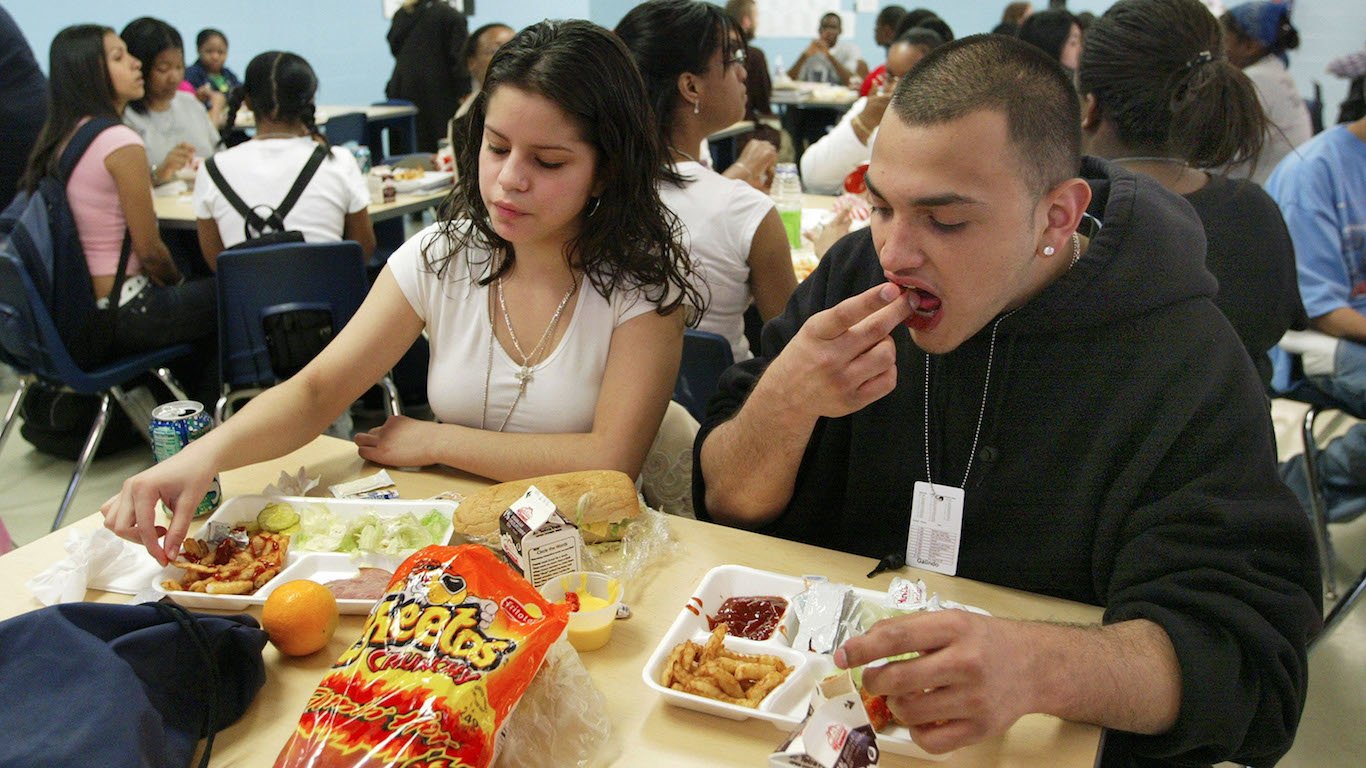

Teenagers are often stereotyped as being impulsive, reckless, and prone to risky behavior. The reality is more nuanced — adolescents are generally less likely than adults to risk the contempt of their peers, for example. But the teen years are a time of dramatic change, and young people do tend to engage in risky behaviors as they encounter dangerous and unhealthy situations on their paths to adulthood.
In fact, from tragic accidents to poor decisions with unforeseen outcomes to the emotional trials of uncomfortable social situations, teenagers face a range of unique health risks. The pervasiveness of such risky behaviors among teens varies heavily by state.
Several factors often more prevalent in some states than in others can affect risky behavior. Household income, parental level of education, and the quality of schools and neighborhoods can all significantly affect the behaviors of teenagers and can have major impacts on health outcomes such as youth obesity, teen pregnancy, and, ultimately, youth mortality.
24/7 Wall St. developed an index based on several measures related to alcohol and other drug use, diet, weight control, physical activity, sexual behavior, tobacco use, and proneness to injury and violence with data from the Centers for Disease Control and Prevention’s Youth Risk Behavior Surveillance System. We listed the 12 states where high school students engage in the most risky behavior.
Click here to see the states where high school students have the riskiest behaviors.
Click here to see our detailed findings and methodology.

12. Iowa
> Teen binge drinking rate: 13.4%
> Teen smoking rate: 9.9%
> Are sexually active: 32.7%
> Text while driving: 55.2%
> Graduation rate: 91.3%
A larger share of high schoolers engage in risky behavior in Iowa than in a majority of states. An estimated 32.7% of Iowa high schoolers are sexually active, far more than the 28.7% of high schoolers nationwide and the third largest share of any state.
Iowa teenagers are also among the most likely of any state to engage in dangerous behavior while driving. Americans living in rural settings are more likely to report risky driving behavior than urban dwellers, and 89% of highways in Iowa are rural — one of the largest shares of any state. Some 55.2% of high schoolers in Iowa have texted or emailed while driving, and 20.8% have ridden with a driver who had been drinking alcohol — the largest and fourth largest shares nationwide, respectively.
[in-text-ad]

11. Texas
> Teen binge drinking rate: 11.8%
> Teen smoking rate: 7.4%
> Are sexually active: 27.5%
> Text while driving: 39.3%
> Graduation rate: 89.1%
Some 23.1% of high school survey respondents reported using no method of birth control during their most recent sexual encounter, far more than the 13.8% of respondents nationwide and the largest share of any state. Risky sexual behavior among Texas teens has likely contributed to the high rate of teen pregnancy in the state. There were 31 births per 1,000 teens aged 15 to 19 in Texas in 2016, the third highest teen pregnancy rate of any state.
Texas teenagers also report some of the highest rates of attempted suicide and drunk driving.

10. Michigan
> Teen binge drinking rate: 13.2%
> Teen smoking rate: 10.5%
> Are sexually active: 28.3%
> Text while driving: 39.4%
> Graduation rate: 79.7%
Almost one-quarter of Michigan’s high school students report using marijuana, the fourth highest share among states. While some states have legalized the drug, it remains illegal in Michigan, which means students who use the drug are risking a criminal record. Long-term use of the drug among youth has been shown to have detrimental effects on brain development. State high school students also engage in above-average rates of many risky behaviors. For example, 24.4% of students had been in a physical fights, the fourth-highest percentage among states.
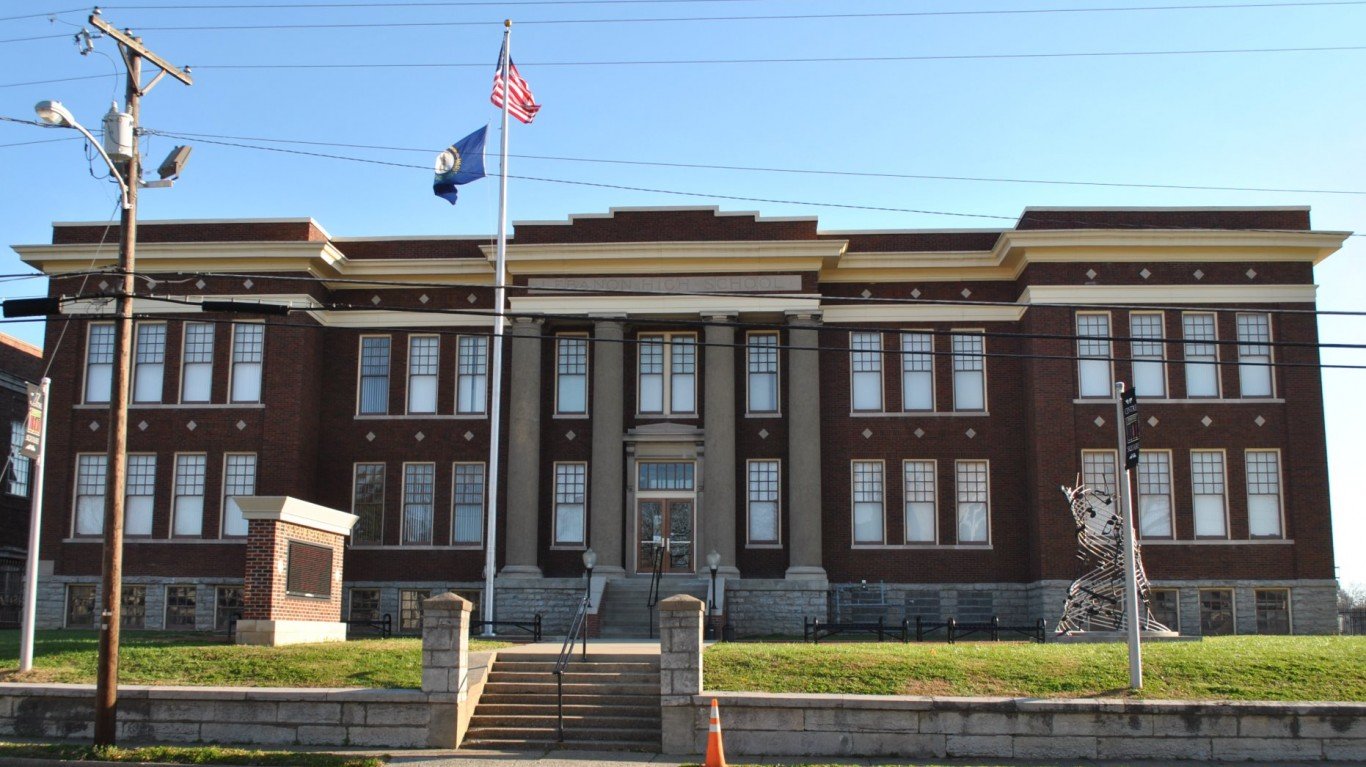
9. Kentucky
> Teen binge drinking rate: 13.2%
> Teen smoking rate: 14.3%
> Are sexually active: 29.0%
> Text while driving: 34.7%
> Graduation rate: 88.6%
Most states where a higher share of high school students engage in risky behavior have lower incomes. Kentucky’s median annual household income of $46,659 is more than $10,000 below the national median income. Low incomes are associated with a variety of unhealthy and risky behaviors among teenagers and adults alike. Chief among these is tobacco consumption, one of the largest causes of preventable death in the United States. While 8.8% of U.S. high school students report smoking, 14.3% of Kentucky high school students currently smoke, the second highest share among states.
[in-text-ad-2]
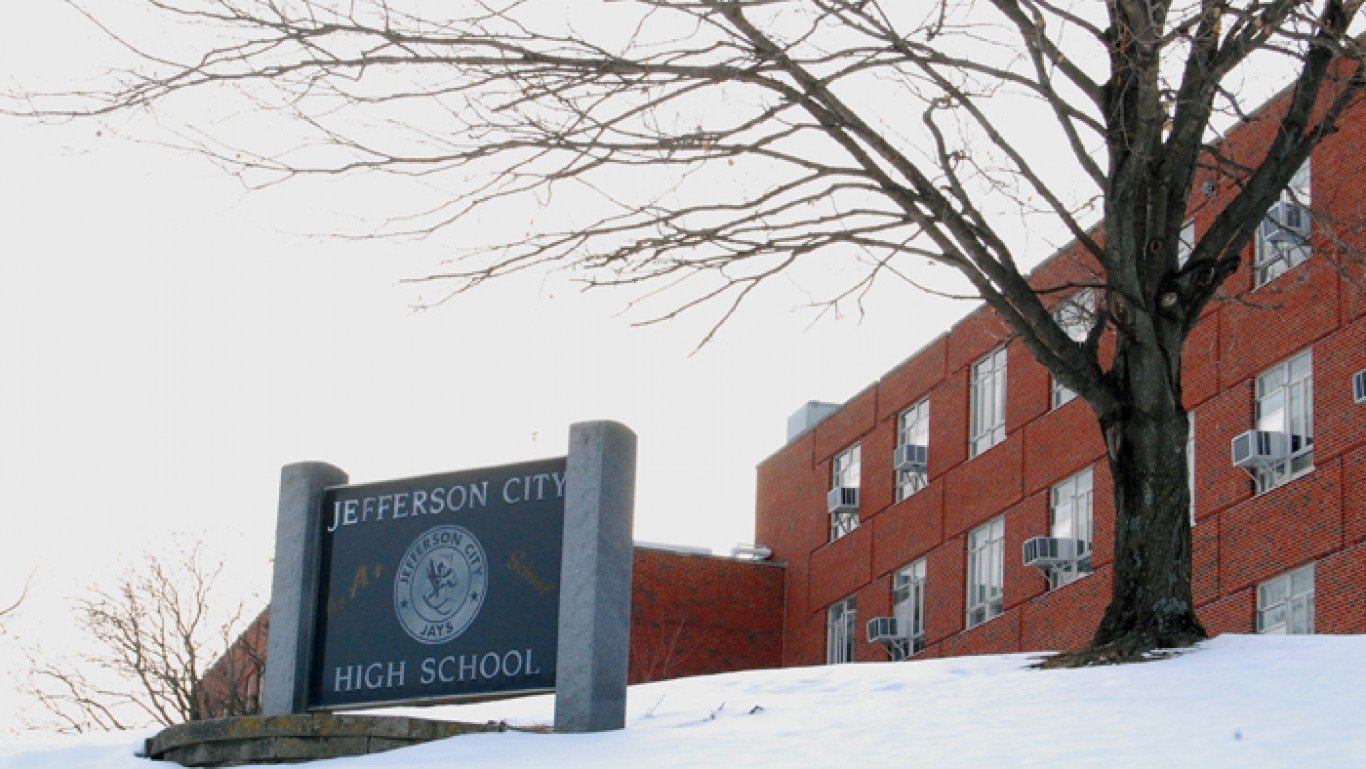
8. Missouri
> Teen binge drinking rate: 17.0%
> Teen smoking rate: 9.2%
> Are sexually active: 32.3%
> Text while driving: 46.4%
> Graduation rate: 89.0%
Missouri’s high school students are among the most likely in the country to be sexually active, and also the most likely to have intercourse without using a condom. Likely partly as a result, the state has one of the higher teen pregnancy rates among states as well. Missouri’s high schoolers are also among the most likely to drink early — and to excess. Among state high school students, 18.4% of said they had their first drink before the age of 13, and 17% reported currently engaging in binge drinking activity, compared to 15.5% and 13.5% of high school students nationwide, respectively.
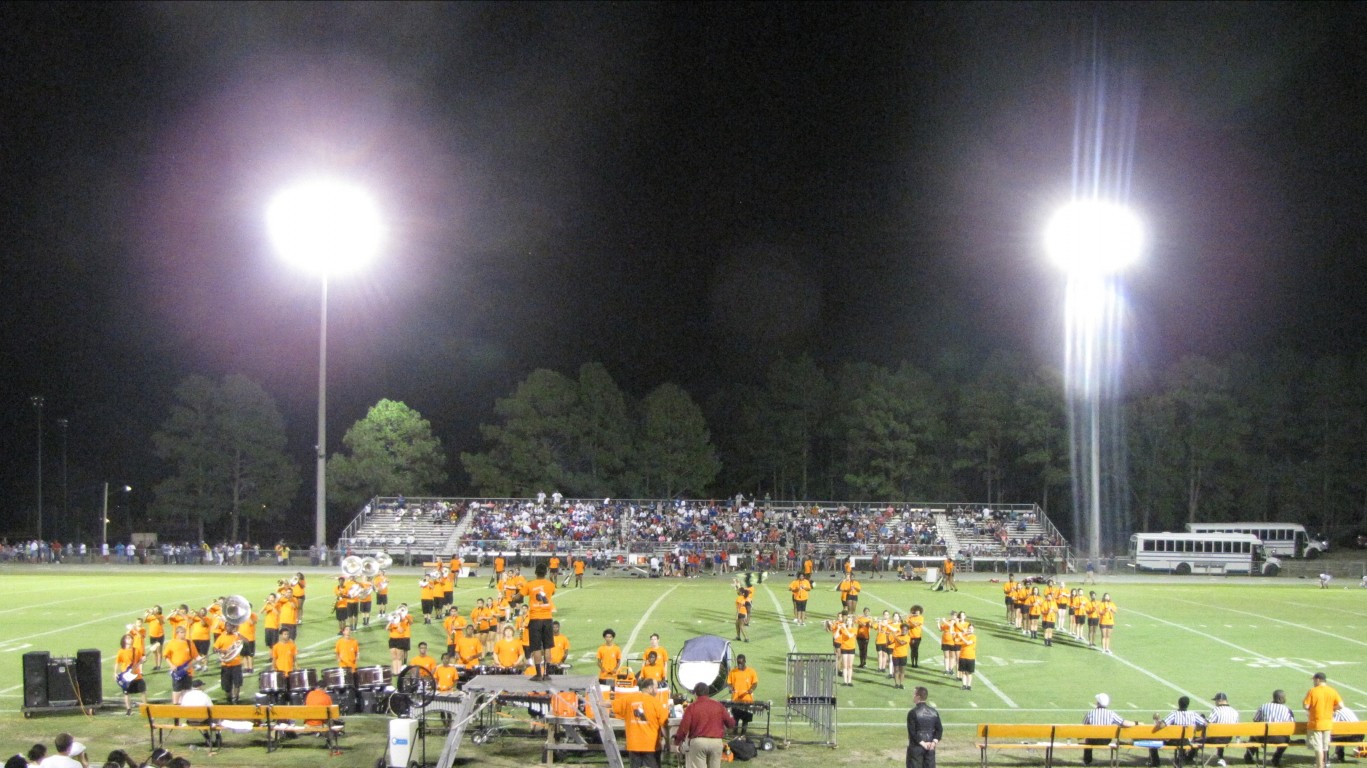
7. South Carolina
> Teen binge drinking rate: 10.4%
> Teen smoking rate: 10.0%
> Are sexually active: 25.0%
> Text while driving: 45.4%
> Graduation rate: 82.6%
While South Carolina high schoolers are less likely to drink alcohol than their peers in most states, rates of illicit drug use are higher than they are nationwide. Some 4.8% of high schoolers have used methamphetamines, 4.4% have used heroin, and 6.4% have used cocaine, respectively the third, fourth, and fifth largest such shares of any state.
Adolescents from households with higher incomes and parental education levels are less likely to engage in a number of risky behaviors. In South Carolina, the typical household earns $49,501 a year, $8,000 less than the national median household income. Some 27.2% of adults have a bachelor’s degree, compared to 31.3% of adults nationwide.
[in-text-ad]
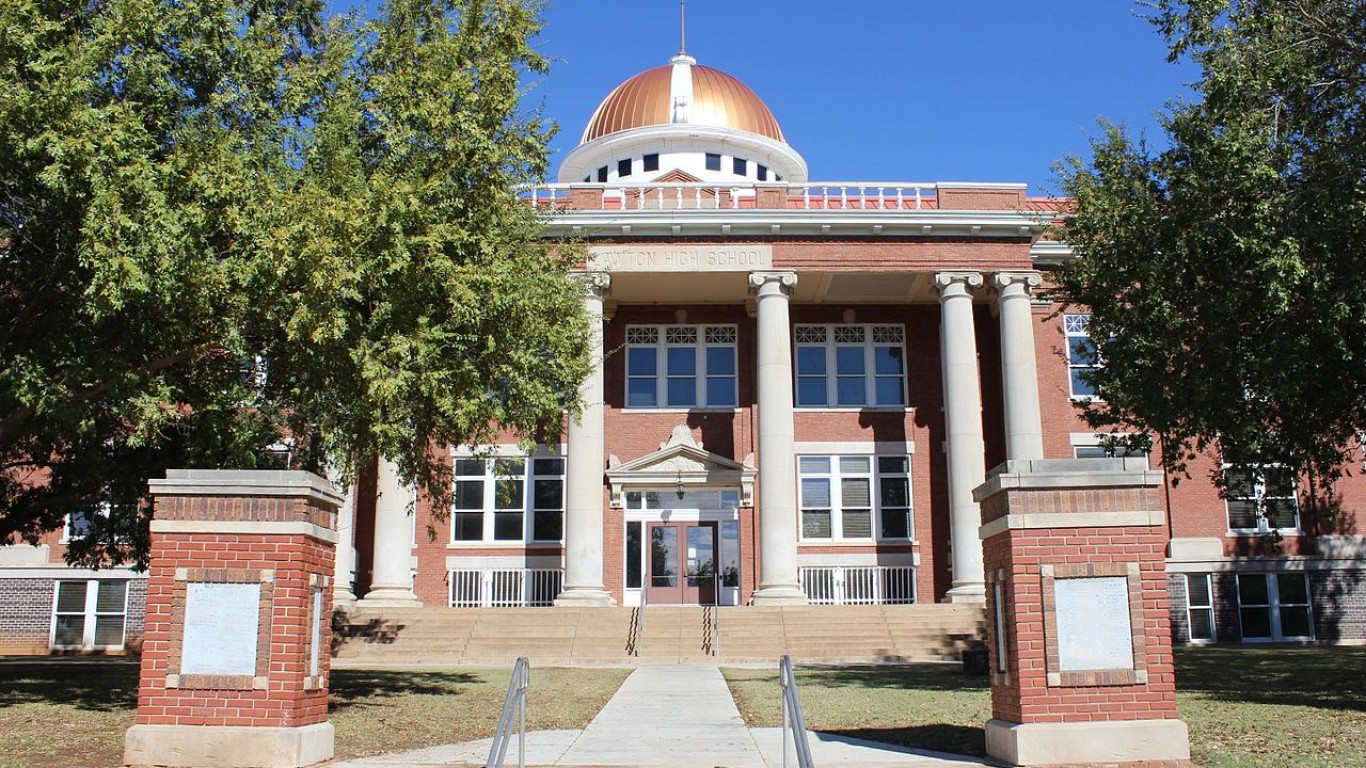
6. Oklahoma
> Teen binge drinking rate: 14.2%
> Teen smoking rate: 12.5%
> Are sexually active: 28.4%
> Text while driving: 45.7%
> Graduation rate: 81.6%
A higher share of Oklahoma teenagers engage in risky sexual behavior than teenagers on average nationwide. In Oklahoma, some 4.2% of high schoolers report having had sexual intercourse before they were 13 years old, the fifth largest share of any state. An estimated 42.8% of high schoolers have had sex, and 11.4% have had sex with at least four partners — the sixth and fifth largest such shares, respectively. Risky sexual behavior among Oklahoma teens has likely contributed to the high rate of teen pregnancy in the state. There were 33.4 births per 1,000 teens aged 15 to 19 in Oklahoma in 2016, one of the highest rates of any state.

5. Montana
> Teen binge drinking rate: 17.6%
> Teen smoking rate: 12.1%
> Are sexually active: 31.6%
> Text while driving: 54.2%
> Graduation rate: 85.6%
Montana teenagers are among the most likely of any state to engage in dangerous behavior while driving. Americans living in rural settings are more likely to report risky driving behavior than urban dwellers, and 96% of highways in Montana are rural — the third largest share of any state after North and South Dakota. Some 54.2% of high schoolers in Iowa have texted or emailed while driving, and 19.2% have ridden with a driver who had been drinking alcohol — the second and seventh largest shares nationwide, respectively. The state’s dangerous driving culture and its consequences likely extend to all age groups. According to the Insurance Institute for Highway Safety, there were 1.4 motor vehicle deaths per 100 million vehicle miles traveled in 2016, among the most of any state. Some 50% of drivers killed had a blood alcohol content above the legal limit of 0.08%, the largest share nationwide.
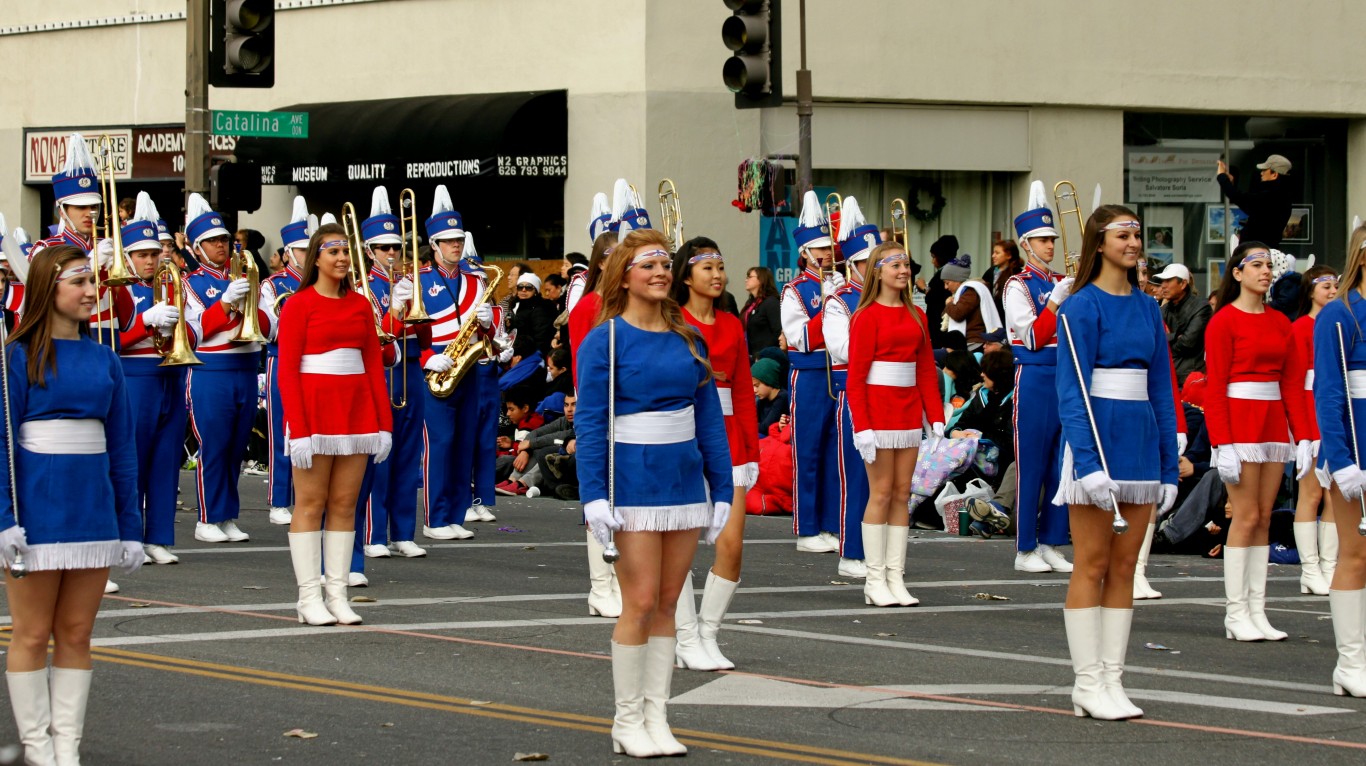
4. West Virginia
> Teen binge drinking rate: 14.3%
> Teen smoking rate: 14.4%
> Are sexually active: 33.5%
> Text while driving: 34.0%
> Graduation rate: 89.8%
Some 19.4% of high schoolers in West Virginia had tried alcohol before the age of 13, and 8.8% had tried marijuana before 13 — the fourth and sixth largest such shares of any state, respectively. Trying alcohol and illegal drugs at an early age can result in health problems and increase the likelihood that it will lead to more dangerous drugs later in life. Some 6.0% of high school survey respondents in West Virginia report having tried cocaine, and 3.4% heroin, each far greater than respective national shares of 4.8% and 1.7%. The high rates of illicit drug use in West Virginia may also contribute to the state’s high rate of drug death. There are an average of 5.5 drug overdose deaths per 100,000 teens 15 to 19 year olds each year in West Virginia, the fifth most of any state.
[in-text-ad-2]
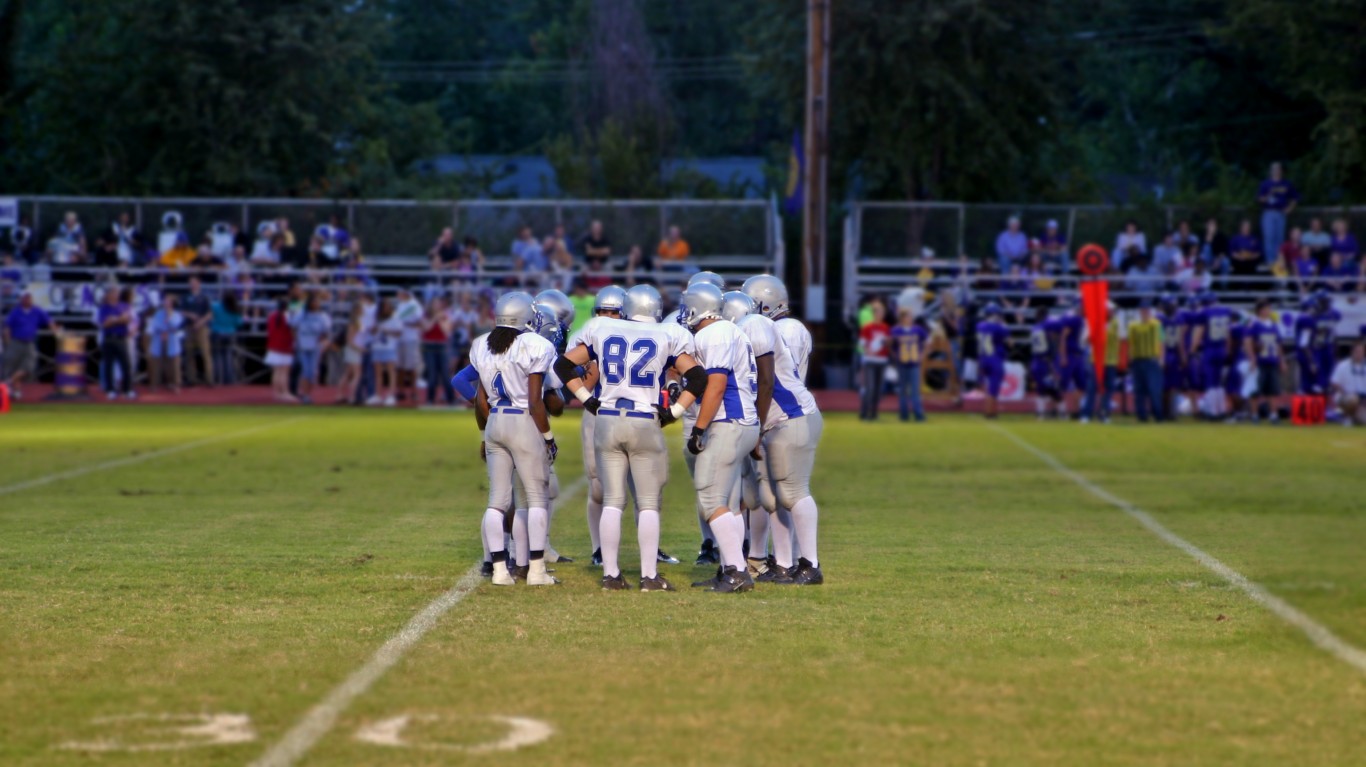
3. New Mexico
> Teen binge drinking rate: 10.9%
> Teen smoking rate: 10.6%
> Are sexually active: 27.0%
> Text while driving: 39.6%
> Graduation rate: 71.0%
New Mexico has some of the highest rates of teenage drug use in the country. Some 27.3% of high schoolers report currently using marijuana, 9.4% report having used cocaine, and 7.1% report having used ecstasy, the largest, second largest, and third largest such shares nationwide, respectively. Additionally, 3.4% of high schoolers in New Mexico have used heroin, twice the 1.7% national figure. Excessive drug use in New Mexico is one factor contributing to the state’s high unintentional death rate. There are an average of 5.5 drug overdose deaths per 100,000 residents aged 15 to 19 in New Mexico each year, the second most of any state after Nevada.
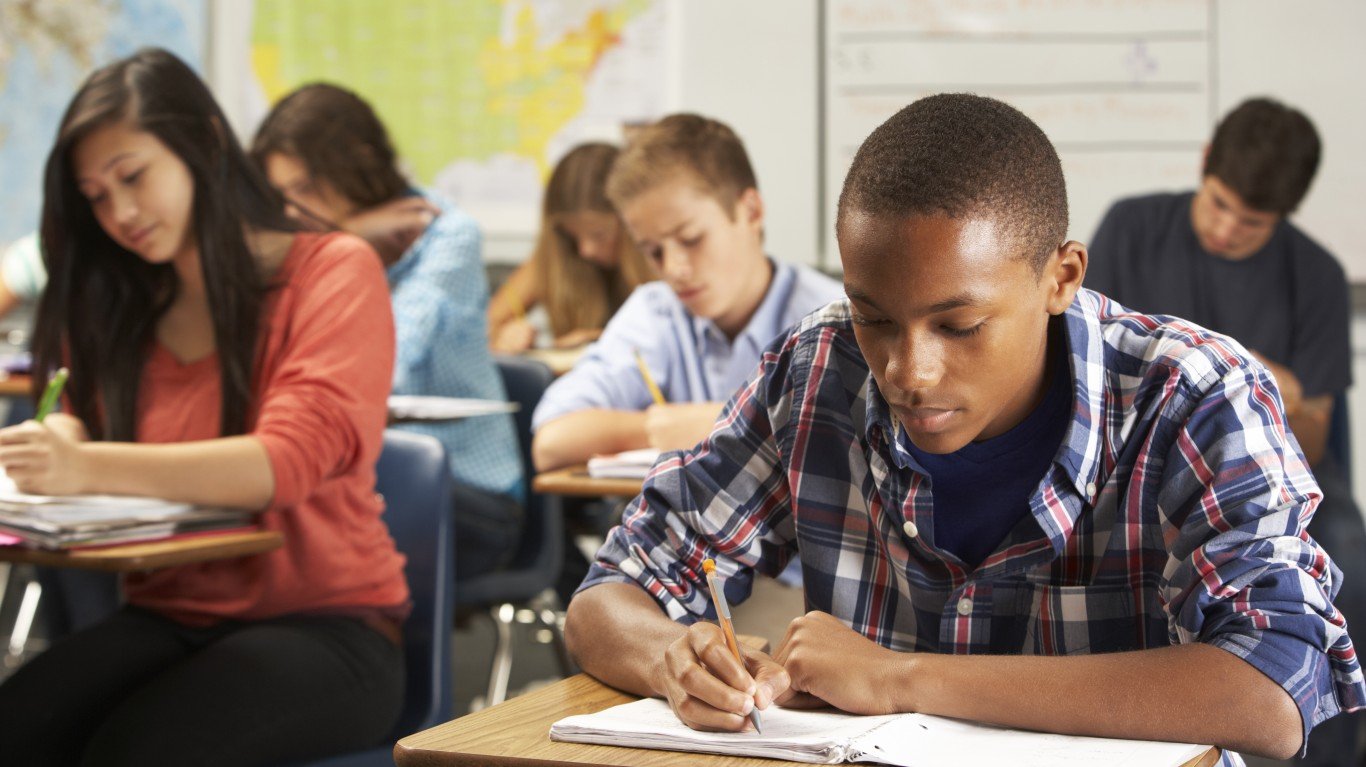
2. Louisiana
> Teen binge drinking rate: 13.0%
> Teen smoking rate: 12.3%
> Are sexually active: 0.0%
> Text while driving: 43.0%
> Graduation rate: 78.6%
By the time they were 13, an estimated 21.7% of Louisiana high schoolers had tried alcohol, and 9.4% had tried marijuana — the second and fourth largest such shares of any state, respectively. Early alcohol and drug use can result in health problems and increase the likelihood that teenagers will drink and use illicit drugs later in life. Today, some 34.0% of Louisiana high schoolers drink alcohol, 9.9% have tried cocaine, and 9.6% have tried heroin, each the largest such share nationwide.
Louisiana teenagers are also among the most likely of any state to engage in dangerous behavior while driving. An estimated 10.0% of Louisiana high schoolers have driven drunk, nearly twice the 5.5% national figure.
[in-text-ad]
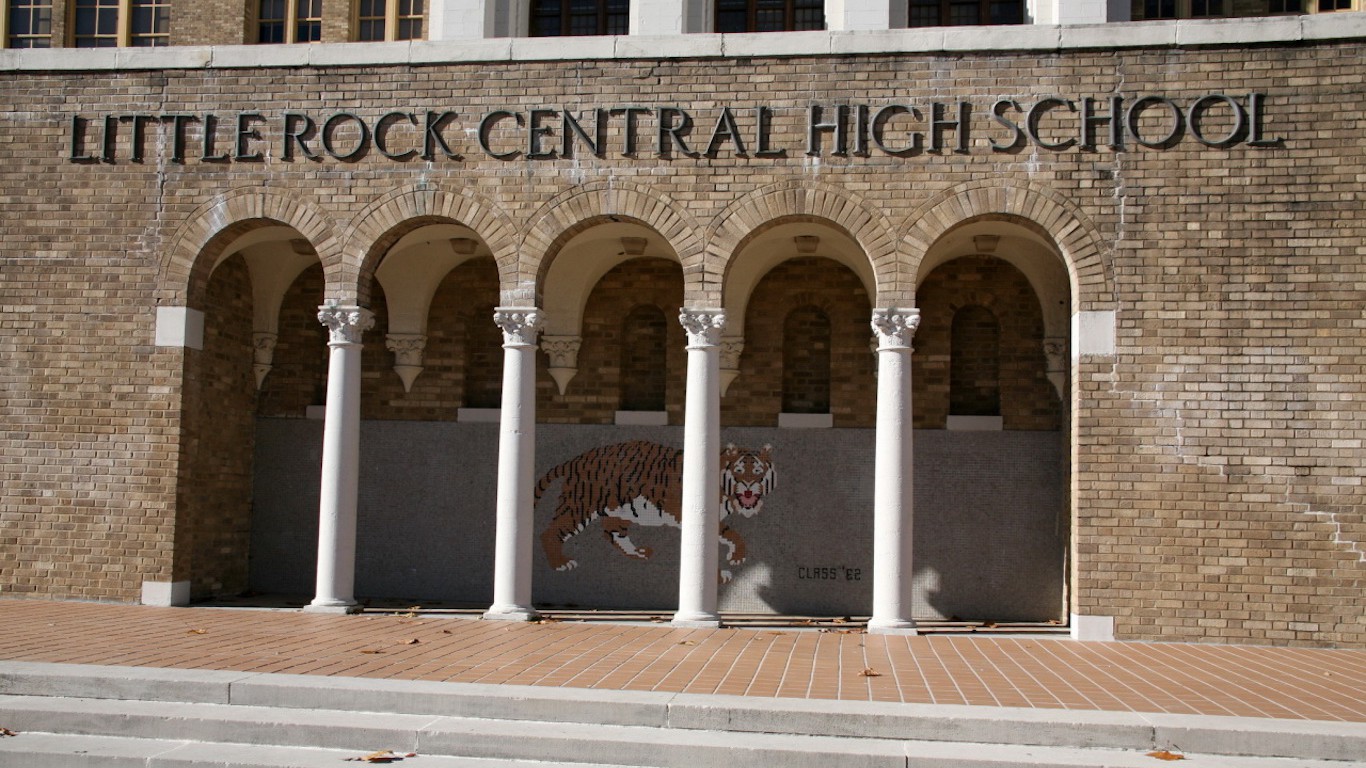
1. Arkansas
> Teen binge drinking rate: 11.7%
> Teen smoking rate: 13.7%
> Are sexually active: 30.9%
> Text while driving: 46.2%
> Graduation rate: 87.0%
A larger share of high schoolers in Arkansas drink and use illegal drugs than in any other state. Some 22.5% of high schoolers in the state drank alcohol before the age of 13, and 10.6% tried marijuana before they were 13, compared to the corresponding nationwide average shares of 15.5% and 6.8%. An estimated 9.4% of high schoolers have used cocaine, and 7.7% have used heroin, each the second largest share of any state.
Arkansas teenagers are also more sexually active and a larger share engage in unsafe sex compared to American high schoolers on average. Unsafe sex can increase the likelihood of contracting STDs or unwanted pregnancy. Some 12.7% of high schoolers in Arkansas have had at least four sexual partners, and 19.8% did not use birth control during their most recent sexual encounter — the largest and second largest such shares, respectively. There were 34.6 births per 1,000 teens aged 15 to 19 in Arkansas in 2016, the highest teenage pregnancy rate in the country.
Detailed Findings and Methodology:
Accidents like motor vehicle crashes, as well as suicides and homicides, are the causes in 6.5% of all deaths among Americans aged 20 and above. For younger Americans, these largely preventable deaths are a far greater concern, accounting for approximately 75% of deaths among Americans aged 15 to 19.
The abuse of substances — both those that are illegal across all age groups, like heroin, ecstasy, cocaine, and marijuana, and those that are illegal for teens, like alcohol and tobacco — poses risks for young adults. The use of these substances among teens poses serious health risks through overdose or developmental damage. It can also lead to legal trouble, which can affect long-term career prospects and even lead to incarceration.
The most commonly used illegal substance is marijuana, with about one in five high school students reporting using the drug. Alcohol abuse at a young age is also common, as 13.5% of American high school students said they currently engage in binge drinking.
Smoking cigarettes is one of the greatest single causes of preventable death in the United States. While smoking among high school students has declined, mirroring the national trend, an estimated 8.8% of high school students still actively smoke. The rate is above 14% in states like Kentucky and West Virginia, two of the states that rank as having the highest share of teens that engage in risky behaviors in the country.
Many young people engage in risky sexual behaviors, such as not using birth control, consuming alcohol before sex, and sex without a condom. Such behaviors can lead to unintended health outcomes and other consequences. While the teenage birth rate has fallen in recent years, many of the 209,809 pregnancies carried to term by 15 to 19 year olds in 2016 were unwanted. Young women who do not use a method of contraception at their first sexual encounter are twice as likely to become teen mothers, and the teen birth rate is much higher in states with higher rates of unprotected sex.
In 11 of the 16 states in which a higher share of high schoolers report not using any method of contraception during their last sexual than the 13.8% national rate, the teen birth rate is also greater than the national figure. Teenage mothers are more likely to drop out of high school and face unemployment as an adult than women who do not give birth during adolescence.
In general, the states where students engage in the riskiest behavior also tend to have lower household incomes, as well as a larger share of adults without a high school diploma. All 12 states on this list have median household incomes below the national median. Of the 12 states, seven have below average high school attainment rates among adults.
Research shows that children in poverty are more likely to have behavioral issues in school, and low incomes are associated with other unhealthy behaviors that both high school students and adults engage in, such as unhealthy diets and smoking.
To determine the state where high school students have the riskiest behaviors, 24/7 Wall St. developed an index based on several measures related to alcohol and other drug use, diet, weight control, physical activity, sexual behavior, tobacco use, and proneness to injury and violence with data from the Centers for Disease Control and Prevention’s Youth Risk Behavior Surveillance System. The index was composed of the share of ninth through 12th grade students who binge drink, the share of high schoolers who had their first drink of alcohol before the age of 13, the share of high schoolers who have used heroin, the share who have used cocaine, currently use marijuana, currently drink alcohol, are sexually active, had sexual interourse before the age of 13, did not use any method of birth control in their most recent sexual encounter, who currently use smokeless tobacco, who currently smoke cigarettes, who have been in a physical fight, have texted or emailed while driving, have ridden in a car with a driver who had been drinking alcohol, who rarely or never wear a seatbelt, and who carry a weapon. Supplementary data on median household income, educational attainment, and poverty came from the U.S. Census Bureau’s 2016 American Community Survey.
Data on teen births per 1,000 females ages 15 to 19 for 2016 also came from the CDC. Data on average annual unintentional deaths per 100,000 people aged 15 to 19 for the period 2007 to 2016 came from the CDC WONDER database. The four-year adjusted cohort graduation rate for public high schools came from the National Center for Education Statistics and is for the 2015-16 school year.
Take This Retirement Quiz To Get Matched With A Financial Advisor (Sponsored)
Take the quiz below to get matched with a financial advisor today.
Each advisor has been vetted by SmartAsset and is held to a fiduciary standard to act in your best interests.
Here’s how it works:
1. Answer SmartAsset advisor match quiz
2. Review your pre-screened matches at your leisure. Check out the
advisors’ profiles.
3. Speak with advisors at no cost to you. Have an introductory call on the phone or introduction in person and choose whom to work with in the future
Take the retirement quiz right here.
Thank you for reading! Have some feedback for us?
Contact the 24/7 Wall St. editorial team.

